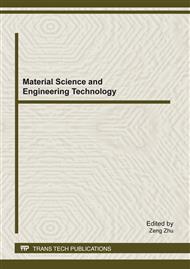p.738
p.743
p.748
p.753
p.757
p.763
p.769
p.775
p.783
A Rotor Position Detection Method of SRM by Measuring Mutually Induced Voltages
Abstract:
This paper describes a method of indirect rotor position measuring for sensorless SRM. The principle is based on measuring the mutually induced voltage in the two inactive phase which is adjacent to the energized phase of the SRM. The mutual voltage in the inactive phase, induced due to the current in the active phase, varies with the position of the rotor. In this paper the SRM was seen as a Differential transformer. One phase was chosen as the primary coil of the transformer, and the adjacent two phases were the Secondary coils. The two Secondary coils were connected in anti-series. A sine wave signal was poured to the primary coil and then we measured the mutual-inductance voltage and processed in a microcontroller to estimate the position of the rotor. The feasibility of the method was proved by an experiment of 8/6 pole four-phase switched reluctance motor.
Info:
Periodical:
Pages:
757-762
Citation:
Online since:
February 2012
Keywords:
Price:
Сopyright:
© 2012 Trans Tech Publications Ltd. All Rights Reserved
Share:
Citation:


